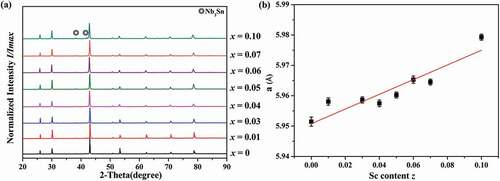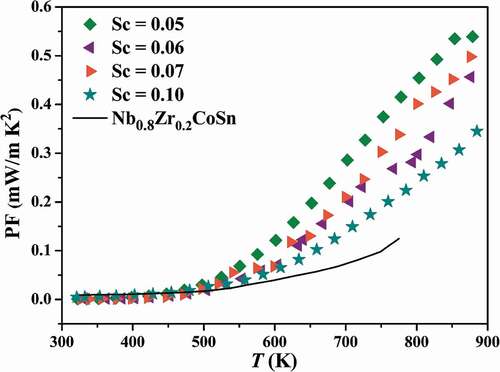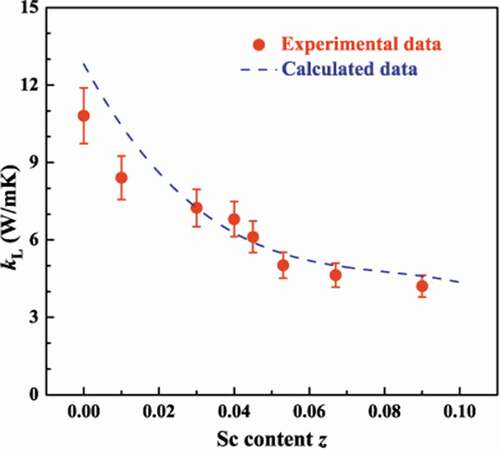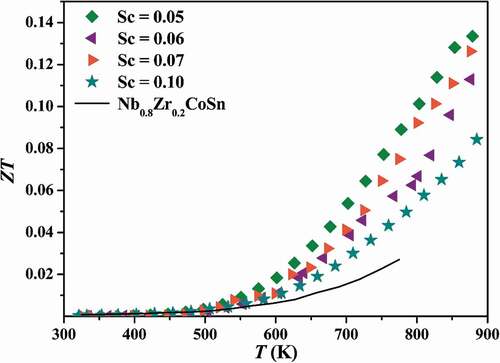 ?Mathematical formulae have been encoded as MathML and are displayed in this HTML version using MathJax in order to improve their display. Uncheck the box to turn MathJax off. This feature requires Javascript. Click on a formula to zoom.
?Mathematical formulae have been encoded as MathML and are displayed in this HTML version using MathJax in order to improve their display. Uncheck the box to turn MathJax off. This feature requires Javascript. Click on a formula to zoom.ABSTRACT
N-type half-Heusler NbCoSn is a promising thermoelectric material due to favourable electronic properties. It has attracted much attention for thermoelectric applications while the desired p-type NbCoSn counterpart shows poor thermoelectric performance. In this work, p-type NbCoSn has been obtained using Sc substitution at the Nb site, and their thermoelectric properties were investigated. Of all samples, Nb0.95Sc0.05CoSn compound shows a maximum power factor of 0.54 mW/mK2 which is the highest among the previously reported values of p-type NbCoSn. With the suppression of thermal conductivity, p-type Nb0.95Sc0.05CoSn compound shows the highest measured figure of merit ZT = 0.13 at 879 K.
GRAPHICAL ABSTRACT

1. Introduction
Thermoelectric (TE) devices can directly convert waste heat into electricity via the Seebeck effect, which is a promising reliable alternative to mechanical converters if the efficiency can be improved [Citation1]. This could become a pathway to more sustainable energy converters in times of energy consumption [Citation2–5]. However, up to now the application of thermoelectric devices is limited by the low energy conversion efficiency η, which is essentially decided by the materials’ dimensionless figure of merit ZT: ZT = S2σT/κ (κ = κc + κL), where S is the Seebeck coefficient, σ is the electrical conductivity, κ is the total thermal conductivity (κc and κL are the carrier and lattice components of κ, respectively), and T is the absolute temperature [Citation6,Citation7]. Thus, the combination of high S, σ and low κ is desirable for a large ZT. Unfortunately, these thermoelectric parameters are strongly coupled via carrier concentration and mobility [Citation8–10], making it difficult to optimize one single parameter without altering the others. Therefore, it has been quite challenging to develop highly efficient thermoelectric materials. The strategic goals of TE research are to discover new materials with high TE performance and/or improve the performance of the existing well-known materials, such as SiGe alloy [Citation10], PbTe [Citation11], chalcogenides [Citation12], skutterudites [Citation13,Citation14], clathrates [Citation15,Citation16], Zintl phases [Citation17] as well as full/half-Heusler compounds [Citation18,Citation19] by band engineering and carrier filtering effect [Citation20–22], phonon engineering [Citation23,Citation24], reducing the dimension of materials [Citation25], or spin fluctuation [Citation26].
Due to the excellent electrical and mechanical properties, high-temperature stability, and possibility to use non-critical elements, half-Heusler (HH) compounds have become attractive candidates for thermoelectric application [Citation27–31]. This compound has a general formula XYZ (X, Y = transition metals, Z = main group elements), crystallizing in cubic C1b structure, space group [Citation32,Citation33]. An empirical rule proposed by Mahan and Sofo [Citation34] states that the best thermoelectric performance is found with materials whose band gap is about 10kBT0, where kB is the Boltzmann constant and T0 is the operating temperature of the device. NbCoSn is one of HH thermoelectric compounds with a band gap of 0.987 eV [Citation35], and such a band gap fulfils the ‘10kBT0ʹ rule. In addition, the small electronegative difference between Co (1.88) and Sn (1.96) ensures larger carrier mobility. Therefore, NbCoSn is a promising mid-high temperature thermoelectric material. Unsubstituted NbCoSn is an intrinsically n-type semiconductor. In 2006 Ono et al. [Citation36] investigated the Sb and Ti substituted n-type NbCoSn and the highest ZT of 0.3 was achieved for the Nb0.99Ti0.01CoSn0.9Sb0.1 at 850 K. A decade later, He et al. [Citation37] synthesized n-type NbCoSn1-xSbx samples by arc melting combined with ball milling and hot-pressing processes, and the highest ZT reached ~0.6 at 1000 K for NbCoSn0.9Sb0.1. Generally, a TE device needs not only high ZT in n-type and p-type materials, but the n-type and p-type materials should have similar compositions and thus comparable mechanical properties and thermal expansion coefficient. For instance, n-type MNi(Sn,Sb) [Citation38] and p-type MCo(Sb,Sn) [Citation39,Citation40] (M = Zr and Hf) compounds fulfil such criteria, and the thermoelectric module made of them reaches a record-high conversion efficiency of 12.4% with a temperature difference of 698 K [Citation41]. To fabricate p-n NbCoSn couple, a p-type NbCoSn based compound is needed to match with the developed n-type NbCoSn compounds. However, few efforts have been devoted to investigating p-type NbCoSn. To the best of our knowledge, Ferluccio et al. [Citation42] first realized p-type NbCoSn via substituting Ti and Zr at Nb site, and the maximum ZT value for p-type Nb0.8Zr0.2CoSn is only 0.03 at ~790 K. Obviously, the ZT value of p-type Nb0.8Zr0.2CoSn compounds is much inferior to those of n-type counterparts. Therefore, it is crucial to identify new p-type dopants and further improve the thermoelectric performance of p-type NbCoSn.
In this work, the NbCoSn compound has been prepared through arc melting followed by annealing processes, and then Sc, chosen as a p-type dopant, is substituted at Nb site to obtain Nb1-zSczCoSn (z ≤ 0.1). There are two main reasons for choosing Sc as a p-type dopant: (1) The substitution of Nb (III B) by Sc (V B) can create more holes in this compound and further achieve a p-type NbCoSn. (2) The larger mass fluctuation between Nb (92.91 g/mol) and Sc (44.96 g/mol) can strengthen defect and alloying phonon scattering which can significantly suppress the lattice thermal conductivity. It is found that Nb1-zSczCoSn compound possesses p-type conducting behaviour when Sc = 0.05. The highest power factor of this p-type compound is 0.54 mW m−1 K−2, which is 230% higher than the reported value of Nb0.8Zr0.2CoSn [Citation42]. As a result, a peak ZT of ~0.13 is achieved.
2. Experimental details
Nb1-zSczCoSn (z ≤ 0.1) compounds were prepared by arc-melting stoichiometric amounts of the elements Nb (wire, 99.999%), Sc (piece, 99.99%), Co (bulk, 99.999%), Sn (shot, 99.999%) in Ar atmosphere. The ingots were melted several times with flipping twice over each time to ensure homogeneity. The obtained ingots were sealed into evacuated quartz tubes, annealing at 1173 K for 7 days. And then the bars and pellets for measurements were prepared by cutting these annealed ingots.
The crystal structures of samples were investigated by powder X-ray diffraction (PXRD) on a Rigaku diffractometer (Rigaku, Japan) using Cu Κα radiation (λ0 = 1.5418 Å). The microstructures of polished samples were characterized by scanning electron microscopy (SEM; Zeiss Gemini, Germany), and the phase compositions were analyzed by energy-dispersive X-ray spectroscopy (EDX; Bruker, Germany). Electrical transport properties (Seebeck coefficient and electrical conductivity) were simultaneously measured by a ZEM-3 instrument (Ulvac-Riko, Japan) under He atmosphere from 300 to 900 K. The measurement errors for all samples are around ±3% (electrical conductivity) and ±5% (Seebeck coefficient). The Hall carrier concentration pH (nH) and mobility μH were calculated via pH = 1/eRH (nH = ﹣1/eRH) and μH = σRH, where e is unit charge and RH is the Hall coefficient measured by commercial Physical Properties Measurement System (PPMS; Quantum Design, USA) under magnetic fields from −5.2 T to 5.2 T. The thermal conductivity was calculated by the formula κ = DCpds, where D is thermal diffusivity measured by laser flash instrument (NETZSCH, LFA457, Germany) by coating all samples with a thin layer of graphite to minimize emissivity errors (the actual measurement error is about 3%), Cp is specific heat derived by temperature-dependent heat data using the differential thermal analyzer (NETZSCH, DSC204F1, Germany), and ds is the samples’ density estimated by the Archimedes method. The relative densities of these samples are about 95%.
3. Results and discussion
3.1. Phase and microstructure
The cubic NbCoSn crystal structure is shown in . The element Nb (4a site) and Co (4b site) frame the NaCl sublattice with octahedral coordination, leaving the all tetrahedral central sites (4c site) to the element Sn, but only half of the 4c site is occupied by Sn, forming this half-Heusler compound. Simply, by applying the Zintl chemistry concept [Citation43], this crystal structure can be described into an anionic framework [CoSn]5- formed by the tetrahedral coordination of Co and Sn, and an electropositive Nb5+ filled in the octahedral voids formed by these tetrahedral frameworks.
PXRD patterns of Nb1-zSczCoSn (z = 0, 0.01, 0.03, 0.04, 0.05, 0.06, 0.07, 0.10) samples are shown in ). The diffraction peaks of all the samples can be indexed to MgAgAs cubic crystal structure despite some minor Nb3Sn impurity phases, indicating all samples possess the HH phase. As it is visible from ), the unit cell parameter calculated via PowderCell [Citation44] software increases with the increasing Sc content. Since the ionic radius of Sc3+ (0.87 Å) is larger than that of Nb5+ (0.74 Å) [Citation45], the observed lattice expansion indicates Nb5+ is substituted by Sc3+.
The phase purity and elemental distribution were further examined by SEM combined with EDX mapping. shows the secondary electron image and the EDX maps of a polished Nb0.95Sc0.05CoSn sample, which indicates no obvious phase segregation and uniform elemental distribution on this scale. summarizes the actual chemical compositions of all prepared samples analyzed by EDX, and it shows that the actual chemical compositions are close to the nominal compositions.
Table 1. Nominal, actual compositions by EDX and measured densities of Nb1-zSczCoSn
3.2. Electrical transport properties
shows the electrical transport properties of Nb1-zSczCoSn at different temperatures. For comparison, the literature data of Nb0.8Zr0.2CoSn [Citation42] are also plotted (black line). As displayed in ), the electrical conductivity (σ) of unsubstituted NbCoSn compound decreases with the rise of temperature, showing a metal-like conducting behaviour. While, after substituting Sc at Nb site, the σ gradually increases with increasing temperature, indicating a semiconductor behaviour. Besides, with the Sc concentration up to 0.05, the σ significantly decreases from 5.0 × 104 S/m (NbCoSn) to 0.07 × 104 S/m (Nb0.95Sc0.05CoSn) at room temperature and then goes up to ~0.6 × 104 S/m with further increasing Sc concentration to 0.1 (Nb0.9Sc0.1CoSn). In addition, the band gap can be obtained from the slope of lnσ vs. 1000/T curve (shown in ) using the Arrhenius equation
where ρ0 is a constant. The calculated band gap values are 0.35 eV, 0.33 eV, 0.29 eV and 0.20 eV for p-type Nb0.95Sc0.05CoSn, Nb0.94Sc0.06CoSn, Nb0.93Sc0.07CoSn and Nb0.90Sc0.10CoSn respectively. For the Nb1-zSczCoSn compounds with z > 0.04, the slope of σ-T changes above 500 K and it can be explained by the impact of intrinsic conduction.
To further understand the conduction mechanism, the Hall coefficient at room temperature was measured and the calculated charge carriers concentration and mobility are presented in ). The electron concentration nH for NbCoSn is 17 × 1019 cm−3, which is on the same order of magnitude as compared to the value reported by He et al. (~24 × 1019 cm−3) [Citation37]. Moreover, the nH decreases remarkably with the Sc content reaching 0.04. For z = 0.05, holes become the dominant carriers, and the hole concentration pH increases gradually from 0.8 × 1019 cm−3 to 3.7 × 1019 cm−3 with the Sc content increasing from 0.05 to 0.10. Therefore, Sc is obviously an effective hole (p-type) dopant since it generates acceptor level near the top of the valence band and shifts the Fermi level toward the valence band, resulting in an increase of hole concentration. As for the carrier mobility μH, the trend is similar to that of carrier concentration. Therefore, the σ decreases obviously and then increases slightly with increase of Sc content.
Figure 4. Temperature dependence of the electrical transport properties of Nb1-zSczCoSn (a) electrical conductivity (b) lnσ vs. 1000/T plot
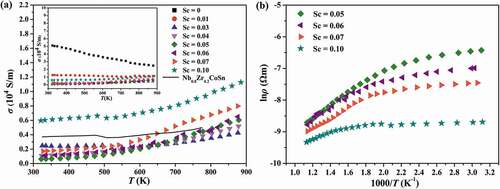
Figure 5. The carrier concentration and carrier mobility of Nb1-zSczCoSn samples at room temperature (a) n-type, (b) p-type

The temperature dependence of Seebeck coefficient (S) in Nb1-zSczCoSn is shown in ). The value of S for unsubstituted NbCoSn is −185 μV/K at room temperature, showing that NbCoSn is apparently an n-type semiconductor. With Sc content increasing, the S of Nb1-zSczCoSn changes gradually from negative to positive with increasing of Sc content, which matches very well with the Hall measurements. The peak value of S reaches ~306 μV/K at 850 K for the Nb0.95Sc0.05CoSn sample, and it is much higher than that (150 μV/K) of Nb0.8Zr0.2CoSn. The single parabolic band (SPB) model is usually used to analyze the transport properties of half-Heusler compounds [Citation46]. Assuming electron conduction occurs within an SPB, the Seebeck coefficient of a non-degenerate semiconductor is related to the effective mass m*, carrier concentration pH and scattering parameter λ via
where e is the elementary charge and h is the Planck constant [Citation47]. For the NbCoSn compound, we assume that acoustic phonon scattering is the predominant scattering mechanism, thus λ = 0. According to the measured S and pH, the m* = 0.11me is obtained. With the m* = 0.11me and the EquationEquation (2)(2)
(2) , we can plot S at 300 K as a function of pH, a plot well-known as a ‘Pisarenko relation’. As shown in ), the red line is the calculated Pisarenko plot, and the blue dots represent measured data of Nb1-zSczCoSn compounds. Most of the data lie on the calculated line, except for that of Nb0.93Sc0.07CoSn compound. The reason for such an exception is not clear yet. It is suspected that the second phase or/and the deviation of the composition may be responsible for such an exception.
Figure 6. Temperature dependence of the Seebeck coefficient (a) and the Seebeck coefficient versus the carrier concentration (p-type) (b) of Nb1-zSczCoSn samples
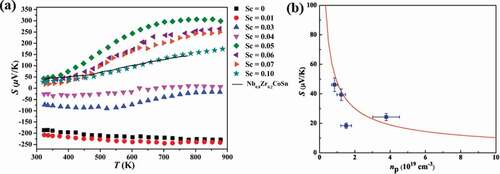
Accordingly, the power factor (PF) was calculated via PF = S2σ and is shown in . The highest PF of 0.54 mW/mK2 is achieved for Nb0.95Sc0.05CoSn compound mainly due to its high S, and it is 3 times higher than that of p-type Nb0.8Zr0.2CoSn (0.125 mW/mK2) [Citation42]. However, the PF of Nb0.95Sc0.05CoSn is still much lower than the state of the art p-type HH compounds, such as (Ti/Hf)Co(SbSn) [Citation39] and NbFeSb [Citation48]. Therefore, much more effort must be devoted to optimizing the carrier concentration of p-type NbCoSn compounds.
3.3. Thermal transport properties
The temperature dependence of total thermal conductivity (κ) and lattice thermal conductivity (κL) are displayed in . The κc is calculated by using the Wiedemann-Franz law: κc = LσT, where L is Lorenz number estimated by Fermi integral, and then κL is derived from the value subtracting the carrier component κc from the total thermal conductivity. Because of the low electrical conductivity, the calculated κc is much lower than κL. In other words, for Nb1-zSczCoSn compounds κL ≈ κ. As shown in ), the κL of unsubstituted NbCoSn is ~10.8 W/mK at room temperature, and this value is similar as compared to the result reported by Ferluccio et al. [Citation42]. After substituting Sc, the room temperature κL decreases dramatically to 4.2 W/mK for Nb0.9Sc0.1CoSn, where a reduction of 60% is achieved after Sc substitution. Such a significant reduction mainly ascribes to the point defect scattering due to the substantial atomic mass difference (mass fluctuation) and interatomic coupling force differences (strain field fluctuation) between Nb and Sc, thereby giving rise to the reduction of κL, especially at room temperature.
Figure 8. The temperature dependence of total thermal conductivity κ (a) and lattice thermal conductivity κL (b)
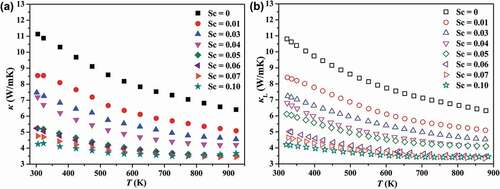
To explain the reduction of κL in terms of the phonon scattering mechanisms, the lattice thermal conductivity of Nb1-zSczCoSn can be evaluated via Debye-Callaway model [Citation49]:
where x is the reduced frequency (x = hω/2kBT), ω is the phonon angular frequency, vs is the sound speed,
is the Planck constant, θD is the Debye temperature, and
is the combined phonon relaxation time. The literature data [Citation42] of θD = 361 K and vs = 3141 m/s for NbCoSn are used in Nb1-zSczCoSn compounds as a good approximation. We assume all phonon scattering processes, including point-defect scattering, boundary scattering, Umklapp scattering, and phonon-free-electron scattering can occur in parallel and thus each adds to the process according to the Matthiessen’s rule, then the
can be formulated in EquationEquation (4)
(4)
(4)
where ,
,
, and
are phonon-point-defect scattering, phonon-boundary scattering, phonon-phonon Umklapp scattering and phonon-free-electron scattering relaxation times, respectively. The
can be obtained through:
where and
are relaxation times of the phonon-point-defect scattering processes due to strain and mass field fluctuations, V is the volume per atom,
and
are the disorder scattering parameters due to strain and mass field fluctuations [Citation50]. The experimental disorder scattering parameters Γexpt (
can be obtained by
where u is the disorder scattering parameter, is the lattice thermal conductivity of the crystal with the disorder, and
is the lattice thermal conductivity of the crystal without disorder [Citation51]. The disorder scattering parameters of Nb1-zSczCoSn compounds calculated according to EquationEquation (6)
(6)
(6) are listed in .
Table 2. The lattice thermal conductivity κL, disorder scattering parameter u, disorder scattering parameters Γexpt.
For the phonon-boundary scattering, is independent of temperature and phonon frequency, and it can be described as
, where d is the grain size of the bulk sample. For the Umklapp scattering,
is dependent on temperature and phonon frequency and can be described as [Citation52]
where is the Grüneisen constant and M is the average atomic mass of the crystal. For the phonon-free-electron scattering process [Citation53], in the case of high carrier concentration
can be described as
where is the deformation potential,
is the sample’s density, and
is the longitudinal sound velocity. With the reference values of physics parameters (Table S1 in Supplementary Information), the lattice thermal conductivity of Nb1-zSczCoSn can be calculated by EquationEquation (3)
(3)
(3) and the results are presented in . In the calculation, we assume that Sc substitution does not significantly affect the basic physics parameters, such as θD,
, Edef and
, so the major variable parameter is
. In such a case, Sc substitution mainly alters the
. Generally, the calculated κL matches with the experimental values, implying that calculations based on Callaway-Debye model can give a rough prediction to the κL of NbCoSn system. In short, at room temperature the reduction of κL of Nb1-zSczCoSn compounds is mainly due to that the Sc substitution induces strong point defect phonon scattering.
3.4. Figure of merit
shows the dimensionless figure of merit ZT of p-type samples. Due to the dramatic enhancement of power factor compared with p-type Nb0.8Zr0.2CoSn, and the significant suppression of thermal conductivity, the highest ZT of p-type Nb0.95Sc0.05CoSn achieves 0.13 at 879 K. It is much higher than that of Nb0.8Zr0.2CoSn [Citation42], indicating Sc is an efficient p-type dopant for NbCoSn as compared to Zr.
4. Conclusions
In this work, homogenous Nb1-zSczCoSn compounds were prepared by an arc-melting process followed by an annealing treatment. The p-type NbCoSn compounds were obtained by substituting iso-electronic Sc at the Nb site and the effects on the electrical and thermal properties were investigated. Generally, the substitution of Sc at Nb site can change the n-type NbCoSn to a p-type semiconductor by adjusting the Fermi level, indicating Sc is an appropriate p-type dopant. Also, the thermal conductivity is reduced. As a result, the highest ZT is 0.13 at 879 K in p-type Nb0.95Sc0.05CoSn sample, which is roughly 5 times higher than that of p-type Nb0.8Zr0.2CoSn.
Supplemental Material
Download MS Word (203.3 KB)Acknowledgments
We would like to acknowledge the financial support from Deutsche Forschungsgemeinschaft (Project No. BA 4171/4-1), and also acknowledge support by the German Research Foundation and the Open Access Publishing Fund of Technische Universität Darmstadt.
Disclosure statement
No potential conflict of interest was reported by the authors.
Supplemental material
Supplemental data for this article can be accessed here.
References
- Populoh S, Brunko OC, Gałązka K, et al. Half- Heusler (TiZrHf)NiSn unileg module with high powder density. Materials. 2013;6(4):1326–1332.
- Bell LE. Cooling, heating, generating power, and recovering waste heat with thermoelectric systems. Science. 2008;321:1457–1467.
- Vining CB. An inconvenient truth about thermoelectrics. Nat Mater. 2009;8:83–85.
- Sootsman JR, Chung DY, Kanatzidis MG. New and old concepts in thermoelectric materials. Angew Chem Int Ed. 2009;48:8616–8639.
- He J, Tritt TM. Advances in thermoelectric materials research: looking back and moving forward. Science. 2017;357:1369–1377.
- Chung DY, Iordanidis L, Choi KS, et al. Complex chalcogenides as thermoelectric materials: A solid state chemistry approach. Bull Korean Chem Soc. 1998;19:1281–1448.
- Petsagkourakis I, Tybrandt K, Crispin X, et al. Thermoelectric materials and applications for energy harvesting power generation. Sci Technol Adv Mater. 2018;19:836–862.
- Zhu T, Liu Y, Fu C, et al. Compromise and synergy in high-efficiency thermoelectric materials. Adv Mater. 2017;29:1605884.
- Yan R, Lin J, You L, et al. Increasing the thermoelectric power factor via Ag substitution at Zn site in Ba(Zn1-xAgx)2Sb2. J Alloy Compd. 2018;745:228–233.
- Muthusamy O, Nishino S, Ghodke S, et al. Low thermal conductivity of bulk amorphous Si1-xGex containing nano-sized crystalline particles synthesized by ball-milling process. J Electron Mater. 2018;47(6):3260–3266.
- Heremans JP, Jovovic V, Toberer ES, et al. Enhancement of thermoelectric efficiency in PbTe by distortion of the electronic density of states. Science. 2008;321:554–557.
- Maignan A, Guilmeau E, Gascoin F, et al. Revisiting some chalcogenides for thermoelectricity. Sci Technol Adv Mater. 2012;13(5):053003.
- Vikrant T, Manjusha B, Priyadarshini B, et al. Microstructure and doping effect on the enhancement of the thermoelectric properties of Ni doped Dy filled CoSb3 skutterudites. Sustain Energ Fuels. 2018;2:2687–2697.
- Kim SW, Kimura Y, Mishima Y. Enhancement of high temperature thermoelectric properties of intermetallic compounds based on a Skutterudite IrSb3 and a half-Heusler TiNiSb. Sci Technol Adv Mater. 2004;5:485–489.
- Ikeda MS, Euchner H, Yan X, et al. Kondo-like phonon scattering in thermoelectric clathrates. Nat Commun. 2019;10:887.
- Tang J, Li Z, Ju J, et al. Soft X-ray photoelectron spectroscopy study of type-I clathrates. Sci Technol Adv Mater. 2008;9(4):044207.
- Yan R, Lv W, Wang K, et al. Enhanced thermoelectric properties of BaZn2Sb2 via a synergistic optimization strategy using co-doped Na and Sr. J Mater Chem A. 2016;4:12119.
- Poon SJ. Recent advances in thermoelectric performance of half-Heusler compounds. Metals. 2018;8:989.
- Zhu H, Mao J, Li Y, et al. Discovery of TaFeSb-based half-Heuslers with high thermoelectric performance. Nat Commun. 2019;10:270.
- Mao J, Liu Z, Zhou J, et al. Advances in thermoelectrics. Adv Phys. 2018;67:69–147.
- Xie W, He J, Zhu S, et al. Simultaneously optimizing the independent thermoelectric properties in (Ti, Zr, Hf)(Co, Ni) Sb alloy by in situ forming InSb nanoinclusions. Acta Mater. 2010;58:4705–4713.
- Xie W, Yan Y, Zhu S, et al. Significant ZT enhancement in p-type Ti(Co,Fe)Sb–InSb nanocomposites via a synergistic high-mobility electron injection, energy-filtering and boundary-scattering approach. Acta Mater. 2013;61:2087–2094.
- Hori T, Shiomi J. Tuning phonon transport spectrum for better thermoelectric materials. Sci Technol Adv Mater. 2018;20:10–25.
- Wan C, Wang Y, Wang N, et al. Development of novel thermoelectric materials by reduction of lattice thermal conductivity. Sci Technol Adv Mater. 2010;11:044306.
- Hinterleitner B, Knapp I, Poneder M, et al. Thermoelectric performance of a metastable thin-film Heusler alloy. Nature. 2019;576:85–90.
- Tsujii N, Nishide A, Hayakawa J, et al. Observation of enhanced thermopower due to spin fluctuation in weak itinerant ferromagnet. Sci Adv. 2019;5:eaat5935.
- Xie W, Weidenkaff A, Tang X, et al. Recent advances in nanostructured thermoelectric half-Heusler compounds. Nanomaterials. 2012;2:379–412.
- Populoh S, Aguirre MH, Brunko O, et al. High figure of Merit in (Ti,Zr,Hf)NiSn half Heusler alloys. Scripta Mat. 2012;66:1073–1076.
- Galazka K, Populoh S, Xie W, et al. Improved thermoelectric performance of (Zr0.3Hf0.7)NiSn half-Heusler compounds by Ta substitution. J Appl Phys. 2014;115:183704.
- Zou T, Jia T, Xie W, et al. Band structure modification of the thermoelectric Heusler-phase TiFe2Sn via Mn substitution. Phys Chem Chem Phys. 2017;19:18273–18278.
- Chen S, Ren Z. Recent progress of half-Heusler for moderate temperature thermoelectric applications. Mater Today. 2013;16(10):387–395.
- Jeitschko W. Transition metal stannides with MgAgAs and MnCu2Al type structure. Metall Trans. 1970;1:3159–3162.
- Kandpal HC, Felser C, Seshadri R. Covalent bonding and the nature of band gaps in some half-Heusler compounds. J Phys D Appl Phys. 2006;39:776–785.
- Sofo JO, Mahan GD. Optimum band gap of a thermoelectric materials. Phys Rev B. 1994;49(7):4565–4570.
- Xi L, Yang J, Wu L, et al. Band engineering and rational design of high-performance thermoelectric materials by first-principles. J Materiomics. 2016;2:114–130.
- Ono Y, Inayama S, Adachi H, et al. Thermoelectrics properties of doped half-Heuslers NbCoSn1-xSbx and Nb0.99Ti0.01CoSn1-xSbx. Jpn J Appl Phys. 2006;45(11):8740–8743.
- He R, Huang L, Wang Y, et al. Enhanced thermoelectric properties of n-type NbCoSn half-Heusler by improving phase purity. APL Mater. 2016;4:104804.
- Yu C, Zhu TJ, Shi RZ, et al. High-performance half-Heusler thermoelectric materials Hf1-x ZrxNiSn1-ySby prepared by levitation melting and spark plasma sintering. Acta Mater. 2009;57:2757–2764.
- Yan X, Liu W, Wang H, et al. Stronger phonon scattering by larger differences in atomic mass and size in p-type half-Heuslers Hf1−xTixCoSb0.8Sn0.2. Energy Environ Sci. 2012;5:7543–7548.
- Poon SJ, Wu D, Zhu S, et al. Half-Heusler phases and nanocomposites as emerging high-ZT thermoelectric materials. J Mater Res. 2011;26:2795–2802.
- Xing Y, Liu R, Liao J, et al. High-efficiency half-Heusler thermoelectric modules enabled by self-propagating synthesis and topologic structure optimization. Energy Environ Sci. 2019;12:3390–3399.
- Ferluccio DA, Smith RI, Buckman J, et al. Impact of Nb vacancies and p-type doping of the NbCoSn-NbCoSb half-Heusler thermoelectrics. Phys Chem Chem Phys. 2018;20:3979–3987.
- Zeier WG, Schmitt J, Hautier G, et al. Engineering half-Heusler thermoelectric materials using Zintl chemistry. Nat Rev Mater. 2016;1:16032.
- Kraus W, Nolze G. Powder Cell - a program fort he representation and manipulation of crystal structures and calculation of the resulting X-ray powder patterns. J Appl Cryst. 1996;29:301–303.
- Shannon RD. Revised effective ionic radii and systematic studies of interatomic distances in Halides and chalcogenides. Acta Cryst. 1976;A32:751–767.
- Qiu Q, Liu Y, Xia K, et al. Grain boundary scattering of charge transport in n-type (Hf,Zr)CoSb half-Heusler thermoelectric materials. Adv Energy Mater. 2019;9:1803447.
- Ioffe AF. Semiconductor thermoelements, and thermoelectric cooling. London: Infosearch Ltd; 1957.
- Fu C, Bai S, Liu Y, et al. Realizing high figure of merit in heavy-band p-type half-Heusler thermoelectric materials. Nat Commun. 2015;6:8144.
- Callaway J. Model for lattice thermal conductivity at low temperatures. Phys Rev. 1959;113:1046–1051.
- Yang J, Meisner GP, Chen L. Strain field fluctuation effects on lattice thermal conductivity of ZrNiSn-based thermoelectric compounds. Appl Phys Lett. 2004;85:1140–1142.
- Fu C, Xie H, Zhu TJ, et al. Enhanced phonon scattering by mass and strain field fluctuations in Nb substituted FeVSb half-Heusler thermoelectric materials. J Appl Phys. 2012;112:124915.
- Toberer ES, Zevalkink A, Snyder GJ. Phonon engineering through crystal chemistry. J Mater Chem. 2011;21:15843–15852.
- Parrott JE. Heat conduction mechanisms in semiconducting materials. Rev Int Hautes Temp Refract. 1979;16:393.


